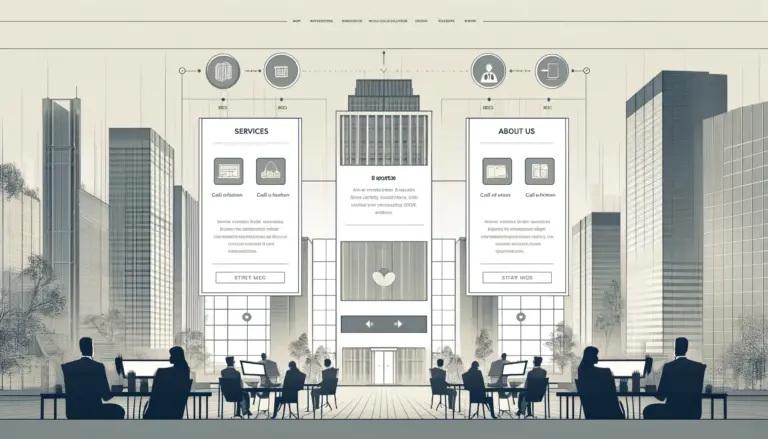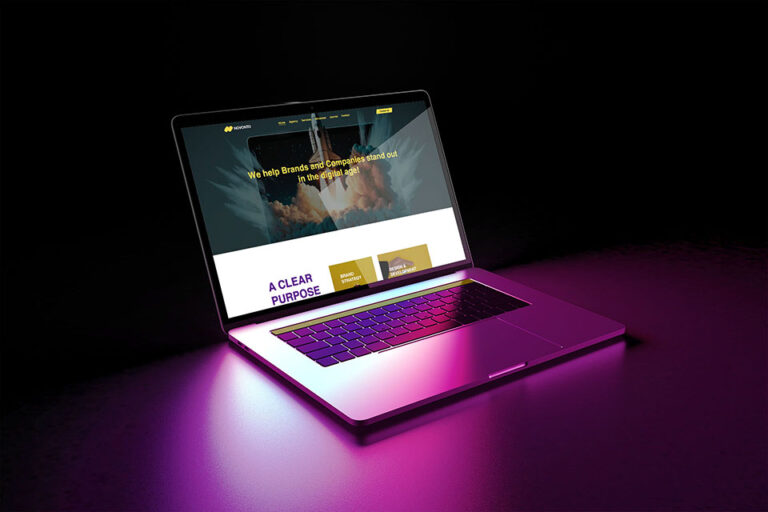Unlike B2C websites, B2B sites focus on long sales cycles, complex purchasing decisions, and a high degree of financial or emotional risk. To meet these demands, your B2B website must prioritize performance, trust, user experience, and clear messaging.
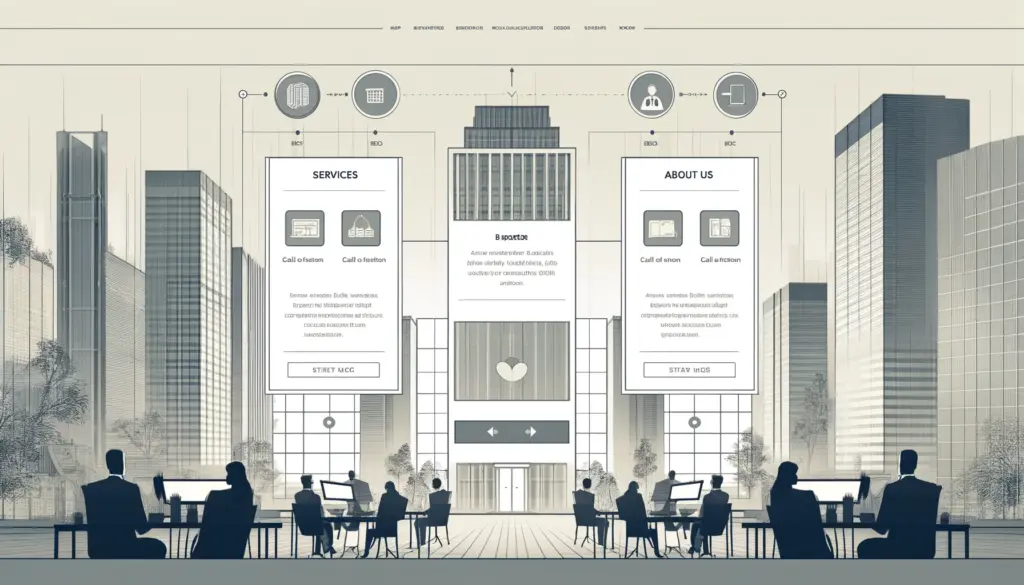
This article will go over key elements of website layouts such as mobile optimization, fast loading times, intuitive navigation, SEO Optimization and a clear messaging that conveys absolute trust, which are all essential parameters of designing and building a b2b business website. In addition to these foundational aspects, Personal branding, authoritative metrics like case studies and testimonials, and industry certifications further build credibility which assist in boosting conversion metrics. And finally, as we enter the era of AI-driven personalization and chatbot integration, staying ahead of technological advancements is vital for future-proofing your B2B website.
Understanding the Scope of B2B Websites
Enterprise websites cater to large transactions between businesses, often involving wholesale quantities of products or high-cost services. On one side, a prime example of this is Alibaba, where manufacturers sell products at scale, offering wholesale prices of products (usually manufactured in China) to buyers & distributors. On the other side, they can also represent services like logistics, business consulting and ESG services. At the end of the day, however, they are both built on the same principles of personal branding, trust and user experience.
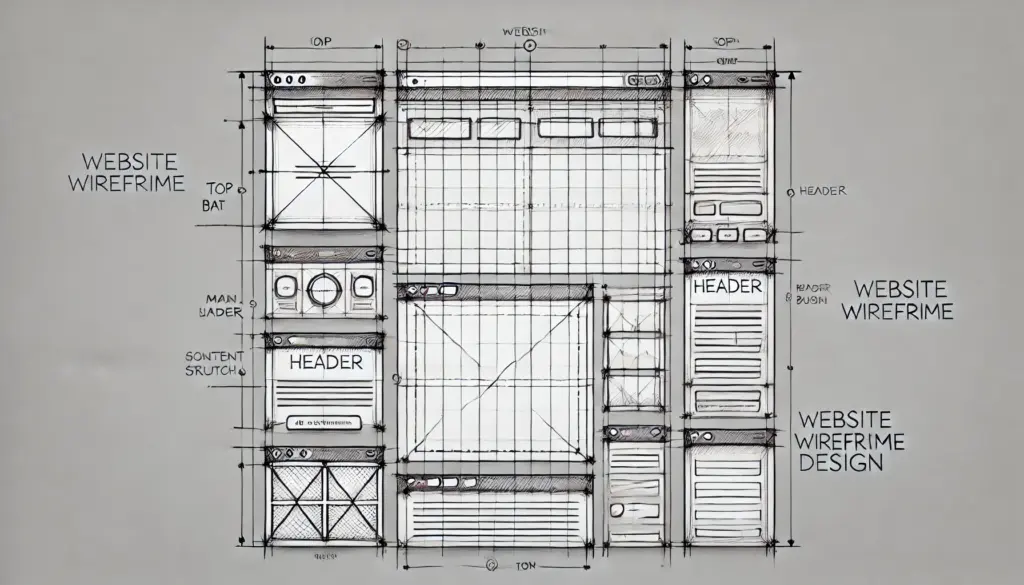
The basis of an effective B2B website is building trust and ensuring a seamless user experience. This requires clear, straightforward messaging that IMMEDIATELY communicates the following:
- What is being offered.
- How to purchase it.
- Why the business should be trusted.
Do a test: send your homepage to a friend and ask them if those questions are answered within 5 seconds of scanning it, 8 seconds as a maximum.
In industries where large financial commitments are made, trust is paramount, and the team behind the website must be perceived as trustworthy and reliable to facilitate conversions.
Related Reading: How to Build a Buyer’s Journey for Complex B2B Sales Cycles
Designing for Considered Purchases
A key component of B2B website design is accommodating the concept of the considered purchase. This type of purchase involves a complex decision-making process, often influenced by multiple key stakeholders who must weigh significant financial or emotional risks and rewards before making a commitment to your business, vs that of your competitors. Unlike B2C transactions, B2B purchases demand thorough investigation, comparison, and validation before a deal is finalized.
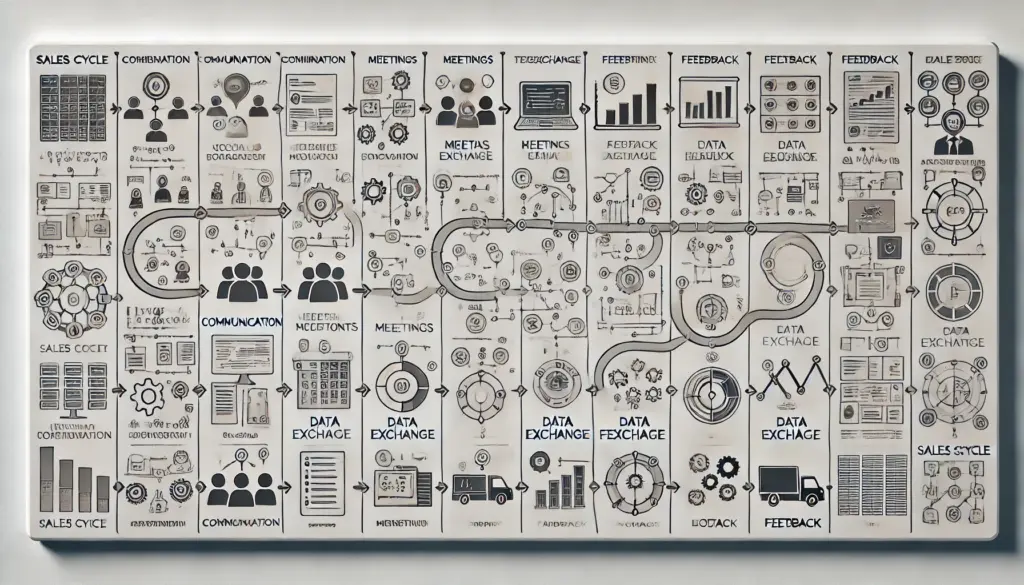
To support this process, B2B websites must prioritize user-friendly design and clear, concise copywriting. Visitors should immediately understand who the business is, what it offers, and why it is trustworthy. The inclusion of statistics, safety certificates, and trust badges, awards won and a solid track record further solidifies the company’s legitimacy, assuring decision-makers that they are engaging with a credible and reliable business.
Key Features of an Effective B2B Website
To create an impactful B2B website, certain key features must be prioritized to enhance user experience and foster trust. First and foremost, intuitive navigation and responsive design are essential for guiding users effortlessly through the customer journey, regardless of the device they use. Security measures must also be robust to protect privacy, as well as ensuring users feel safe conducting large transactions.
For B2B eCommerce sites, comprehensive product descriptions, high-quality videos, and professional images are crucial in conveying the exact specifications, the value and functionality of the offerings. Flexible payment options make the purchasing process smoother, while a well-developed “About Us” section builds trust by highlighting the leadership team and their expertise. Trust is further reinforced through the display of safety certificates and industry-recognized credentials.
Remember that B2B sites cater to much longer sales cycles. To shorten these cycles, it’s vital to make the information clear and easily accessible, helping potential customers quickly understand what you offer and why they should choose your business over competitors.
Building Trust Through Personal Branding & Trust Metrics
In the realm of B2B websites, especially those offering services such as logistics, manufacturing, or business consulting, just for a few examples, personal branding plays a critical role in establishing credibility. The “About Us” section should go beyond just listing company information—it must introduce the key stakeholders and demonstrate their trustworthiness, experience, and expertise within the industry. This personal connection helps prospective clients feel more secure when engaging with your business.
To further enhance credibility, B2B websites should incorporate strong trust metrics. These include customer testimonials, detailed case studies, and relevant certifications. Case studies are especially powerful, as they offer tangible examples of how exactly your business has successfully helped other clients and provide concrete reasons why potential customers should trust you. Highlighting industry awards and certifications, whether they belong to the company or individual leaders, solidifies your business as a credible and reliable player in the market.
Crafting a Seamless B2B eCommerce Experience
In the B2B eCommerce space, the role of the website is critical in facilitating smooth and efficient online transactions. From the moment a customer lands on the site to the checkout process, the entire journey should be effortless. Any friction points can quickly lead to a loss of potential clients. Ensuring that product descriptions are accurate and comprehensive is key, alongside the addition of video demonstrations, which provide a real-life view of the products’ functionality and quality.
Trust can be further established through authoritative content, where products and services are described with expertise and clarity and backed up by studies, white papers and authoritative blogs. It’s essential that both the overall offering and the details of individual products are easy to understand. One of the most important factors is transparency in the fulfillment process—buyers need to know how and when their purchase will arrive after they check out.
In a market as vast and competitive as the UK B2B eCommerce sector, projected to reach $1,364 billion by 2030, maintaining a smooth, informative, and trustworthy eCommerce experience is vital for staying ahead of competitors and securing a share of this booming industry.
Best Practices for B2B Website UX
When designing or outsourcing the creation of a B2B website, following industry best practices is crucial to ensure success. One of the most important considerations is mobile optimization. With an increasing number of users conducting research on their smartphones, your website must be fully responsive across all devices. Additionally, fast loading times are non-negotiable; if your page doesn’t load within three to four seconds, you risk losing valuable prospects to competitor sites.
Search Engine Optimization (SEO) is another critical factor. Your website’s architecture should be optimized to rank high in search results for relevant keywords. By targeting top keywords and refining the SEO of your main pillar pages—such as service and key product pages—you can drive organic and monetary growth simultaneously.
Visual content, including images and videos, plays a significant role in user engagement. In an era of short attention spans, concise video demonstrations of your products and services are essential. Providing users with the option to either read or watch a video enhances their experience in addition to building trust by positioning your company as an authority in the field.
Embracing AI in B2B Website Design & Implementation
As we navigate this transformational era of rapid technological advancement, incorporating AI into B2B website design has become not only beneficial but essential. Since the emergence of AI tools like ChatGPT the pace of AI-driven innovation has accelerated, and it shows no signs of slowing down. For B2B websites, AI-powered personalization is critical in delivering a tailored user experience that drives engagement and conversions.
One key application of AI is the use of chatbots. These chatbots, when properly trained, should integrate seamlessly with your backend systems and customer databases. They must be capable of answering basic customer queries without the need for a human representative, offering immediate support and improving user satisfaction.
Ignoring AI’s growing role in B2B strategies is a risk; companies that fail to adopt AI-driven tools and techniques in their current or future strategies will find themselves falling behind as customers will expect a certain amount of AI automation in the customer journey.
Best Examples of B2B Websites to Benchmark:
1. Alibaba – Wholesale Ecommerce Platform
URL: www.alibaba.com
Alibaba is the world leader in B2B Ecommerce, serving clients around the world buying wholesale “made in China” products to be redistributed around various world markets.
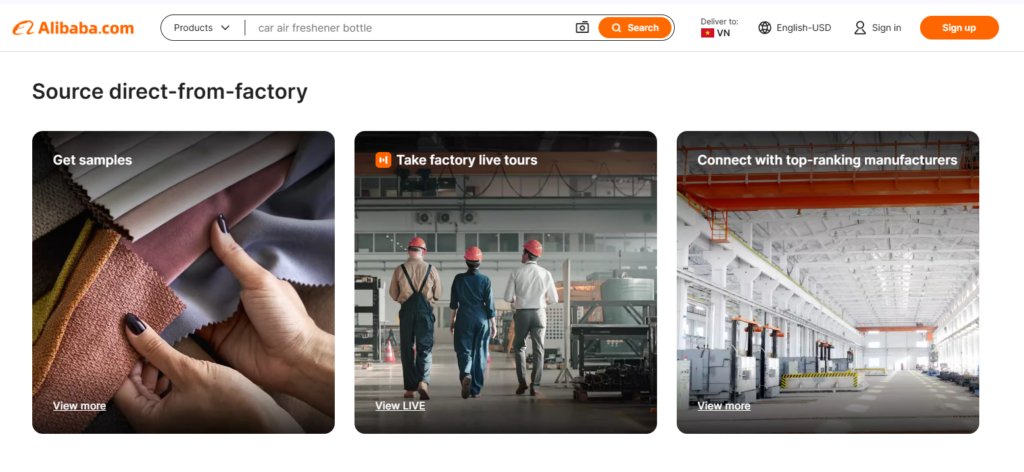
What makes this website great:
Very good search functions and categorization of products that can be bought through their platform. They also offer product samples, factory tours and a deal-making feature which allows you to connect directly with manufacturers. From the perspective of a wholesale product buyer there is no easier platform to use.
2. CBIP Logistics – Logistics Services
URL: cbiplogistics.com/en
CBIP is a 4th party logistics enterprise based in Hong Kong, serving ecommerce clients around the world with their adaptable logistics solutions.

What makes this website great:
Their brand messaging is on-point, you clearly understand their unique value proposition, their mission, their services, and how to engage with those services if you are a E-commerce manufacturer with headquarters in the west with manufacturing done in Asia. They also refrained from using stock images, focusing only on tailored graphics to their brand, which adds to the overall friendly UX of the site. This is an ideal model of website design & development for SMEs to follow.
3. EY (Earnst & Young) – Accounting & Finance
URL: https://www.ey.com/
Ernst & Young (EY) provides a wide range of professional services designed to support businesses in various sectors including assurances, accounting & taxes, auditing, M&A advisory, corporate finance and more. They are considered one of the big 5 accounting firms along with Deloitte, KPMG etc. However within those players we consider EY to have indisputably the best website design.
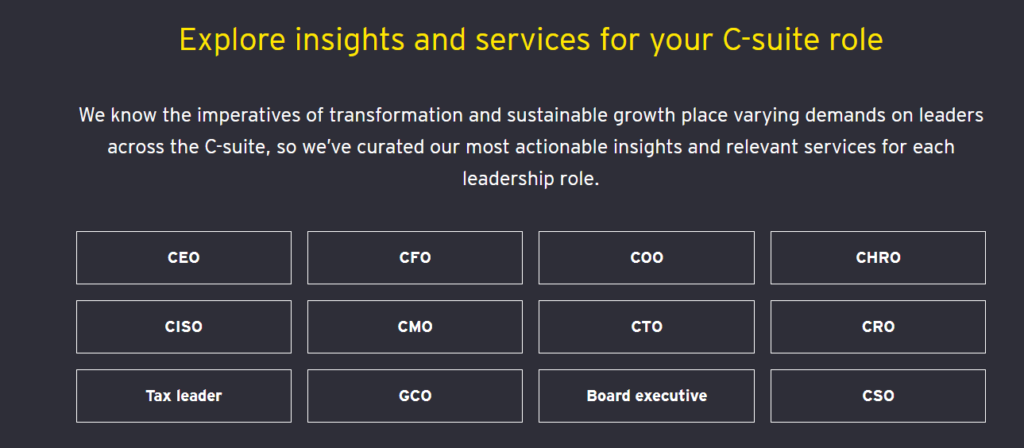
What makes this website great:
EY’s website is sleek, fast, modern and very responsive. Compared to the other 4 in its category, its not laden down with a heavy and confusing text-based design. Furthermore it speaks directly to its target audience effectively, being members of the C-suite. This site is listed here for more larger sized businesses to benchmark when they are designing and executing their websites.
Common Mistakes to Avoid in B2B Website Design
When designing a B2B website, it’s crucial to avoid common mistakes that can hinder user experience and conversions. Here are key pitfalls to watch out for:
- Neglecting mobile optimization: Failing to optimize your website for all screen sizes can result in poor user experiences on mobile devices. Ensure your site is fully responsive across desktop, tablet, and smartphone platforms.
- Slow loading times: A slow website will drive users away. Aim for fast loading speeds, as even a few seconds of delay can result in significant customer loss.
- Hiring an inexperienced UX designer: Choosing a UX designer who doesn’t understand your B2B customers can lead to poor design decisions. Make sure your designer is familiar with the specific needs and behaviors of your target audience.
- Ignoring the complexity of B2B sales cycles: B2B sales are longer and more research-intensive than B2C or D2C. Your website must accommodate this by offering detailed, relevant information that helps customers make informed decisions.
By steering clear of these common mistakes, you can ensure that your B2B website delivers a seamless and effective experience for your users.
To Conclude: a Holistic Approach to Web Design & Development
Designing an effective B2B website requires a focus on trust, user experience, and clear communication. Key components include responsive design, fast loading times, and mobile optimization. Comprehensive product descriptions, videos, and flexible payment options enhance user engagement, while personal branding and trust metrics like case studies and certifications build credibility. Understanding the longer, more complex B2B sales cycle is essential, and AI-driven tools like chatbots can streamline user support. By avoiding common mistakes such as neglecting mobile optimization or hiring inexperienced UX designers, businesses can create a high-performing website that drives conversions and fosters lasting relationships.
How We Can Help
At Novonto, we specialize in empowering B2B enterprises by revolutionizing their digital landscapes. Here’s how we can transform your online presence into a high-performance lead generation machine:
Customized Web Solutions
Your website is the cornerstone of your digital presence. We create bespoke web solutions that not only reflect your brand identity but are also optimized to generate high-quality leads. Our approach involves understanding your specific business needs and crafting websites that offer seamless user experiences and integrate cutting-edge technologies.
Strategic B2B Marketing
Marketing should do more than just spread the word; it should open doors to meaningful engagements. We align our marketing strategies with your business objectives to ensure that every campaign delivers on its promise. From SEO, brand authority, to content marketing, our targeted initiatives are designed to attract valuable leads directly to your doorstep.
Service locations: The UK, Netherlands, Turkey – Fully Online

